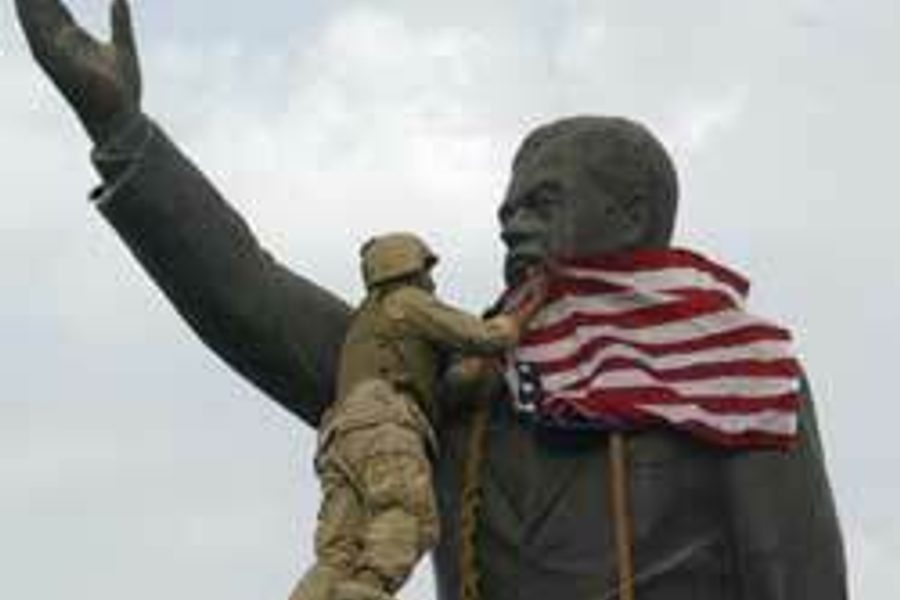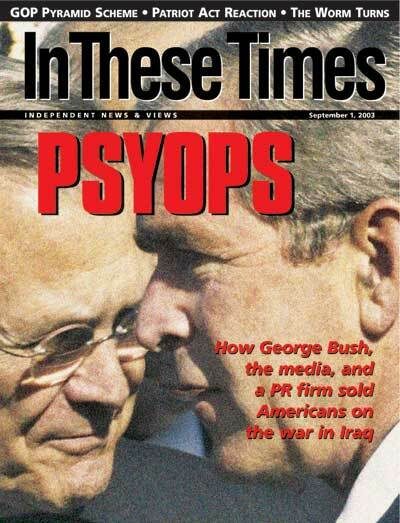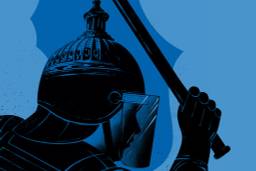How To Sell a War
The Rendon Group deploys ‘perception management’ in the war on Iraq
Sheldon Rampton and John Stauber

As U.S. tanks stormed into Baghdad on April 9, television viewers in the United States got their first feel-good moment of the war – a chance to witness the toppling of a giant statue of Iraqi dictator Saddam Hussein.
Americans channel-flipping over breakfast between Fox, CNN and CBS all saw the same images, broadcast live from Baghdad’s Firdos Square. For those who missed it in the morning, the images were continually replayed on cable news throughout the day, and newspapers carried front-page color photos.
A crowd of jubilant Iraqis had climbed onto the statue, thrown a noose around its neck and tried to pull it down. A man with a sledgehammer began pounding at its concrete base. Others took turns, but the statue was too big and the base too massive, so the U.S. marines moved in with an armored vehicle and a chain. Saddam’s statue first bent from its pedestal and then snapped completely, to roars of approval from the crowd, which surged forward to stomp on its remains, kicking and spitting on the rubble. Whooping, they dragged its head through the street.
Media commentators were quick to assign iconic significance to the statue’s tumble, ranking it alongside the fall of the Berlin Wall, the protesters facing down tanks at Tiananmen Square, and other great events caught on TV.
NBC’s Tom Brokaw compared the event to “all the statues of Lenin [that] came down all across the Soviet Union.”
“Iraqis Celebrate in Baghdad,” reported the Washington Post.
“Jubilant Iraqis Swarm the Streets of Capital,” said the headline in the New York Times.
“It was liberation day in Baghdad,” proclaimed the Boston Globe.
“If you don’t have goose bumps now,” gushed Fox News anchor David Asman, “you will never have them in your life.”
The problem is that the images of toppling statues and exulting Iraqis, to which American audiences were repeatedly exposed, obscured a larger reality. A Reuters long-shot photo of Firdos Square showed that it was nearly empty, ringed by U.S. tanks and marines who had moved in to seal off the square before admitting the Iraqis. A BBC photo sequence of the statue’s toppling also showed a sparse crowd of approximately 200 people – much smaller than the demonstrations only nine days later, when thousands of Iraqis took to the streets of Baghdad calling for U.S.-led forces to leave the city. Los Angeles Times reporter John Daniszewski, who was on the scene to witness the statue’s fall, caught an aspect of the day’s events that the other reporters missed. Most Iraqis were indeed glad to see Saddam go, he wrote, but he spoke near the scene with Iraqi businessman Jarrir Abdel-Kerim, who warned that Americans should not be deceived by the images they were seeing.
“A lot of people are angry at America,” Abdel-Kerim said. “Look how many people they killed. Today I saw some people breaking this monument, but there were people – men and women – who stood there and said in Arabic: ‘Screw America, screw Bush.’ So all this is not a simple situation.”
Perception Management
The visual images, of course, are what most people will remember. But it is worth asking whether the toppling of Saddam was as spontaneous as it was made to appear. If this scene seemed a bit too picture-perfect, perhaps there is a reason. Consider, for example, the remarks that public relations consultant John Rendon – who, during the past decade, has worked extensively on Iraq for the Pentagon and the CIA – made on February 29, 1996, before an audience of cadets at the U.S. Air Force Academy.
“I am not a national security strategist or a military tactician,” Rendon said. “I am a politician, and a person who uses communication to meet public policy or corporate policy objectives. In fact, I am an information warrior and a perception manager.” He reminded the Air Force cadets that when victorious troops rolled into Kuwait City at the end of the first war in the Persian Gulf, they were greeted by hundreds of Kuwaitis waving small American flags. The scene, flashed around the world on television screens, sent the message that U.S. Marines were being welcomed in Kuwait as liberating heroes.
“Did you ever stop to wonder,” Rendon asked, “how the people of Kuwait City, after being held hostage for seven long and painful months, were able to get hand-held American, and for that matter, the flags of other coalition countries?” He paused for effect. “Well, you now know the answer. That was one of my jobs then.”
Of course, we have no way of knowing whether Rendon or any other PR specialist helped influence the toppling of Saddam’s statue or other specific images that the public saw during the war in Iraq. Public relations firms often do their work behind the scenes, and Rendon – with whom the Pentagon signed a new agreement in February 2002 – is usually reticent about his work. But his description of himself as a “perception manager” echoes the language of Pentagon planners, who define “perception management” as “actions to convey and (or) deny selected information and indicators to foreign audiences to influence their emotions, motives, and objective reasoning. … In various ways, perception management combines truth projection, operations security, cover, and deception, and psyops [psychological operations].”
The paradox of the American war in Iraq, however, is that perception management has been much more successful at “influencing the emotions, motives, and objective reasoning” of the American people than it has been at reaching “foreign audiences.” When we see footage of Kuwaitis waving American flags, or of Iraqis cheering while U.S. Marines topple a statue of Saddam, it should be understood that those images target U.S. audiences as much, if not more, than the citizens of Kuwait or Iraq.
It became obvious within days of the toppling of the statue that although the Iraqi people largely welcomed the dictator’s downfall, they were not as eager to throw bouquets of flowers at American soldiers as the scene at Firdos Square seemed to suggest. In Nasiriyah, some 20,000 people rallied to oppose the U.S. military presence on April 15, only six days after the statue fell. “Yes to freedom, yes to Islam,” they chanted. “No to America, no to Saddam.” In other protests, crowds chanted, “No, no, Chalabi” in opposition to Ahmed Chalabi, the U.S.-backed head of the Iraqi National Congress (INC). Newsweek interviewed a high-ranking U.S. military officer who said he was stunned when he began talking to Iraqis, even anti-Saddam locals, about Chalabi’s credibility. “It’s astonishing how little support he has,” the officer said. “I’m afraid we’re backing the wrong horse.”
The “George Washington of Iraq”
In 1991, a few months after the end of Operation Desert Storm, then-president George H.W. Bush signed a presidential directive ordering a CIA covert operation to unseat Saddam Hussein. And the CIA turned to Rendon.
In 1992, the Rendon Group helped organize the INC, which represented the first major attempt by opponents of Saddam Hussein to join forces. According to a February 1998 ABC News report by Peter Jennings, Rendon came up with the name for INC and channeled $12 million of covert CIA funding to it between 1992 and 1996. INC brought together Kurds, Sunni and Shiite Arabs (both Islamic fundamentalist and secular), as well as democrats, nationalists, and ex-military officers. In October 1992, Ahmed Chalabi, a Rendon protégé, was appointed to head the group.
Internal differences led to the group’s virtual collapse, and for years afterwards, Chalabi was mistrusted by the CIA and the Clinton administration, which dropped INC and began funding a rival opposition group, the Iraqi National Accord (INA). That venture also ended disastrously, when a number of INC and INA members were rounded up and killed by Saddam Hussein’s forces.
But despite repeated setbacks, Chalabi remained a frequent visitor to the corridors of power in Washington. Certain circles – the pro-Israel hawks with roots in the Reagan and first Bush administrations who have come to be known as “neoconservatives” – even referred to Chalabi as the “George Washington of Iraq.” As a propaganda effort, the conversion of Chalabi to the equivalent of a founding father was clearly a resounding success. Everyone, including Chalabi, seemed convinced. Chalabi knew how to tell the hawks what they wanted to hear, promising that Saddam’s regime was on its last legs, that INC commanded vast sympathetic support and intelligence assets, and that Iraqi forces would defect en masse as soon as the United States showed the gumption to support a war of liberation.
Chalabi’s political fortunes improved in 1997, when a number of prominent neoconservatives formed the “Project for the New American Century” (PNAC), which lobbied for increasing U.S. military spending and taking a harder line against Iraq. PNAC’s founder and chairman, William Kristol, was a former chief of staff to Vice President Dan Quayle and to Secretary of Education William Bennett (both PNAC founding members themselves). Kristol is better known as the editor of The Weekly Standard, an influential political affairs magazine underwritten by right-wing media mogul Rupert Murdoch. Other PNAC founders, including Dick Cheney, Donald Rumsfeld, Paul Wolfowitz, Richard Perle and Elliott Abrams, would later hold important positions in the second Bush administration.
The inauguration of George W. Bush and the post-9/11 war on terrorism would put the PNAC neoconservatives back in the driver’s seat of U.S. foreign policy. Nine days after the 9/11 attacks, PNAC sent an open letter to President Bush, calling not only for the destruction of Osama bin Laden’s al-Qaeda network, but also to extend the war to Iraq, and to take measures against Iran, Syria, Lebanon and the Palestinian Authority.
The Information War
John Rendon’s refusal to discuss his activities makes it difficult to do more than speculate about the full scope and extent of his firm’s involvement in Iraq, but an incident during the war itself provided a rare breach in the wall of secrecy. On March 23, TV cameraman Paul Moran was killed in northern Iraq by a suicide bomber while on assignment for the Australian Broadcasting Corporation. His obituary, published in his home town of Adelaide, Australia, noted that Moran’s activities “included working for an American public relations company contracted by the U.S. Central Intelligence Agency to run propaganda campaigns against the dictatorship. … Company founder John Rendon flew from the United States to attend Mr. Moran’s funeral in Adelaide on Wednesday. A close friend, Rob Buchan, said the presence of Mr. Rendon – an adviser to the U.S. National Security Council – illustrated the regard in which Mr. Moran was held in U.S. political circles, including the Congress.”
Moran’s work for the Rendon Group apparently included producing the only television interview with Adnan Ihsan Saeed al Haideri, the Iraqi engineer who claimed that he helped build special underground facilities for Saddam’s chemical, biological and nuclear weapons program. According to a report by the Australian news show Dateline, Moran was one of two reporters who were granted access to al Haideri by Chalabi’s INC. (The other was the New York Times’ Judith Miller, whose reporting has come under scrutiny since it was revealed that Chalabi and INC were the primary sources for her numerous stories about Iraq’s alleged weapons of mass destruction. Zaab Sethna, INC spokesman, told Dateline, “The information that al Haideri provided went directly to President Bush, it went to Tony Blair.” Indeed, Bush quoted the information provided by al Haideri in his State of the Union address as he made his case for war. Yet the underground facilities that al Haideri claimed to have helped build have never been found, perhaps because they never existed.
In December 2002, Robert Dreyfuss reported in The American Prospect that the Bush administration actually preferred Chalabi’s INC-supplied analyses of Iraq over the intelligence coming from the CIA. “Even as it prepares for war against Iraq, the Pentagon is already engaged on a second front: its war against the Central Intelligence Agency,” wrote Dreyfuss. “The Pentagon is bringing relentless pressure to bear on the agency to produce intelligence reports more supportive of war with Iraq. … Morale inside the U.S. national-security apparatus is said to be low, with career staffers feeling intimidated and pressured to justify the push for war.” Much of the pro-war faction’s information came from INC, even though “most Iraq hands with long experience in dealing with that country’s tumultuous politics consider INC’s intelligence-gathering abilities to be nearly nil.”
“[INC’s] intelligence isn’t reliable at all,” Vincent Cannistraro, a former senior CIA official and counterterrorism expert, told Dreyfuss. “They make no distinction between intelligence and propaganda, using alleged informants and defectors who say what Chalabi wants them to say, [creating] cooked information that goes right into presidential and vice-presidential speeches.”
Two days before the Saddam regime crumbled in Baghdad, INC – the organization that the Rendon Group had carefully named and packaged 11 years earlier – was ensconced in Iraq.
Chalabi, whose return marked his first opportunity to set foot in Baghdad since his exile in 1958, set up headquarters in the Hunting Club, a private enclave that was previously the club of Saddam’s son Uday. “I am not a candidate for any position in the interim government,” he said. “My role is to rebuild Iraq.” Simultanously, however, his office began to take on the trappings of a government-in-waiting, as throngs of petitioners came clamoring for jobs and favors.
As the war faded, Chalabi’s name began popping up in more and more places. In May, longtime Chalabi aide Francis Brooke – a former Rendon employee – said that Chalabi might bow to popular pressure and agree to become Iraq’s president after all. “George Washington turned it down many times,” Brooke said, apparently without irony. “I wouldn’t be surprised if the Iraqi people prevail on him.” On May 5, U.S. Gen. Jay Garner named Chalabi as one of five Iraqis likely to be appointed as the nucleus of a new interim government.
Psyops
The blurring of boundaries between truth and myth certainly did not begin with the current Bush administration. Disinformation has been a part of war since at least the days of Alexander the Great, who planted large breastplates of armor in the wake of his retreating troops to convince the enemy that his soldiers were giants. The story of Alexander’s little trick is usually taught in the first day of class for soldiers who receive training in psyops.
A 1998 U.S. Air Force manual titled Information Operations, which includes a section titled “Psychological Operations,” states: “There is a growing information infrastructure that transcends industry, the media, and the military, and includes both government and nongovernment entities. It is characterized by a merging of civilian and military information networks and technologies. … In reality, a news broadcast, a diplomatic communiqué, and a military message ordering the execution of an operation all depend on the [global information infrastructure].” In this environment, psyops “are designed to convey selected information and indicators to foreign leaders and audiences to influence their emotions, motives, objective reasoning, and ultimately their behavior,” while “military deception misleads adversaries, causing them to act in accordance with the originator’s objectives.” Indeed, it says, quoting Chinese military strategist Sun Tzu, “All warfare is based on deception.”
More than anybody else, it was the American public who was deceived by administration’s psyops – a covert disinformation campaign that was directed at the American people. In an October 2002 opinion poll by the Pew Research Center for People and the Press, 66 percent of Americans said they believed Saddam Hussein was involved in the 9/11 attacks on the United States, while 79 percent believed that Iraq already possessed, or was close to possessing, nuclear weapons. The principal reason cited by 25 percent of war supporters related to their perceptions of Hussein or the nature of his regime (he’s “evil,” a “madman,” “represses his own people”). However, more than twice that number – 60 percent – gave a reason related to their concerns stemming from 9/11 (getting rid of weapons of mass destruction, preventing future terrorism).
In January, Knight-Ridder Newspapers conducted its own, separate opinion poll. “Two-thirds of the respondents said they thought they had a good grasp of the issues surrounding the Iraqi crisis, but closer questioning revealed large gaps in that knowledge,” it reported. “For instance, half of those surveyed said one or more of the September 11 terrorist hijackers were Iraqi citizens. In fact, none was.” Moreover, “The informed public is considerably less hawkish about war with Iraq than the public as a whole. Those who show themselves to be most knowledgeable about the Iraq situation are significantly less likely to support military action, either to remove Saddam from power or to disarm Iraq.”
This gap between reality and public opinion was not an accident. If the public had possessed a more accurate understanding of the facts, more people would probably have seen a “pre-emptive” war with Iraq as unwise and unwarranted. The public’s erroneous beliefs developed through a steady drumbeat of allegations and insinuations from the Bush administration, pro-war think tanks, and commentators – statements that were often false or misleading and whose purpose was to create the impression that Iraq posed an imminent peril.
True Lies
At a press briefing two weeks after the terrorist attacks of 9/11, Defense Secretary Donald Rumsfeld had an exchange with a reporter that deserves to be quoted in detail:
Reporter: Will there be any circumstances, as you prosecute this campaign, in which anyone in the Department of Defense will be authorized to lie to the news media in order to increase the chances of success of a military operation or gain some other advantage over your adversaries?
Rumsfeld: Of course, this conjures up Winston Churchill’s famous phrase when he said – don’t quote me on this, OK. I don’t want to be quoted on this, so don’t quote me – he said, sometimes the truth is so precious it must be accompanied by a bodyguard of lies, talking about the invasion date and the invasion location, and indeed, they engaged not just in not talking about the date of the Normandy invasion or the location, whether it was to be Normandy Beach or just north off of Belgium, they actually engaged in a plan to confuse the Germans as to where it would happen. And they had a fake army under General Patton, and one thing and another.
That is a piece of history. And I bring it up just for the sake of background.
The answer to your question is no. I cannot imagine a situation. I don’t recall that I’ve ever lied to the press. I don’t intend to. And it seems to me that there will not be reason for it. There are dozens of ways to avoid having to put yourself in a position where you’re lying. And I don’t do it. And [Assistant Secretary of Defense for Public Affairs Victoria Clarke] won’t do it. And [her deputy] Admiral Quigley won’t do it.
Reporter: That goes for everybody in the Department of Defense?
Rumsfeld: You’ve got to be kidding.
The members of the press laughed.





